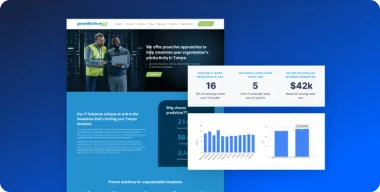Put simply, Google Analytics is the most powerful marketing and data collection tool available to website owners today. That is if you know how to use it and how to get the best return on your investment. Full of complex data and endless streams of information, Analytics can easily take over your already busy schedule.
With heavy integration, Google Analytics is capable of delivering insights into virtually every stage of interaction between your site and your customers, customized to specific desires. It goes without saying why so many business owners are turning to this resource as their go to reporting tool.
Google Analytics and SEO success
It is a disservice for marketing professionals to assume that keyword ranking alone is the definition of effectiveness in the world of SEO. Using Google Analytics, it is easier to separate organic traffic feeds and discover where conversions are coming from. This process also reveals if search is the responsible source of conversion (the stat that pays the bills) or if customers are returning from initial searches and converting on successive views. This helps identify disconnects in search criteria. Lastly, sometimes the best tool provided by Analytics is the ability to express complex data in simple graphs for clearer presentations.
Standard Google Analytics Features
For all its power, Google Analytics is a simple program in concept and design. The basic feature set is centered around discovering what types of traffic you are receiving, where it comes from, and how that is affecting your overall goals. Goals, incidentally, are items you can set for yourself within the program to identify where you’re stacking up and where you need to focus future efforts. With bundled features that break down social media interaction, traffic sources and conversion broken down in near limitless ways, the out-of-the-box experience for Google Analytics is an empowering one.
Leveraging Data Effectively
So you have all of this data, what now? Well, good news, the choice is yours on how you want to leverage all of this information to assist in your business goals, but there’s a solution for just about any project. We’ve already discussed that you can set up goals, which will guide you on your path.
But along with this, KPIs (Key Performance Indicators) are huge. Most people are tracking the wrong things (page visits, tweets, etc.) while this tool can go much deeper than that. Users can get actionable data by increasing specificity in their tracking habits. For example, tracking sales, leads and subscribers broken down per social media interaction is a much more valuable metric for increasing sales.
Features you must have
- Goals: There’s a reason this keeps coming up, mostly because setting goals within Analytics is the single best feature you can leverage to your advantage. Virtually everything you can view within the interface can be tracked and tagged as a goal. Identify where your revenue is generated, and use this information to set goals that keep your business on course.
- AdWords: Many of us take advantage of AdWords but don’t realize there is a wealth of information at your disposal going to waste. Link AdWords to Analytics and explore the possibilities that arise.
- Tracking Campaigns: You’re spending a lot of revenue (presumably) on ad campaigns. You want to know if they’re being effective, where, and to what degree. Using URL tracking, you can very simply manage any editable URL (Email, Facebook, etc.) to isolate and track the performance of all your campaign initiatives.
- Traffic Filtering: Especially early in the process, you are going to spend a large portion of your time inside Google Analytics making tweaks and changing parameters. Use internal filtering to eliminate this non-pertinent traffic from reports, thereby keeping traffic gauges accurate.
- Site Search: This one is often overlooked. When visitors can’t find something on your site, often they use the search function to find what they believe to be missing. Use this data to uncover features and products customers are interested in that may not be present or may be displayed improperly for easy navigation.
- eCommerce Tracking: Assuming you’re selling on your site, you’re going to want to take advantage of eCommerce tracking. Discover where your sales are coming from, and use this information to center your plan of attack around your strengths or bolster your weaknesses.
Common Pitfalls
As with any data collection service, Google Analytics does an excellent job at uncovering mounds of data that can be used to give you an advantage in your market. It is a powerful tool for directing traffic, increasing effectiveness and driving conversion. However, it can be a trap in itself.
Learn how to streamline your data needs and trust your resources. Overcomplicating the query results can produce a micromanaging effect that eliminates the inherent benefits by creating more work, rather than achieving the intended purpose of simplifying the workflow.




